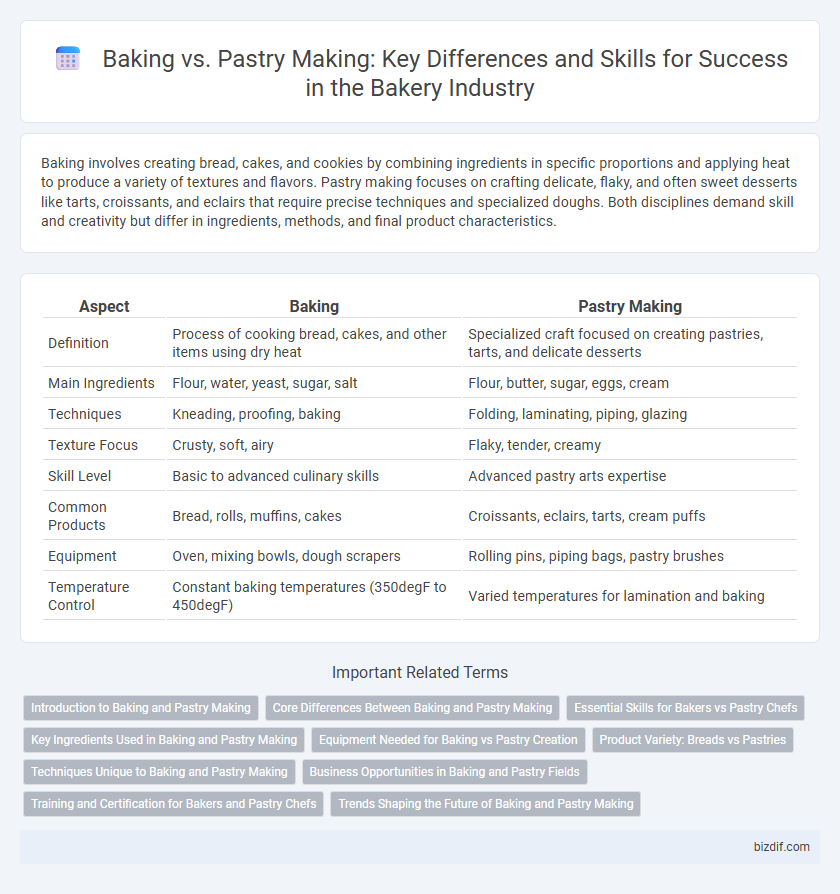Baking involves creating bread, cakes, and cookies by combining ingredients in specific proportions and applying heat to produce a variety of textures and flavors. Pastry making focuses on crafting delicate, flaky, and often sweet desserts like tarts, croissants, and eclairs that require precise techniques and specialized doughs. Both disciplines demand skill and creativity but differ in ingredients, methods, and final product characteristics.
Table of Comparison
| Aspect | Baking | Pastry Making |
|---|---|---|
| Definition | Process of cooking bread, cakes, and other items using dry heat | Specialized craft focused on creating pastries, tarts, and delicate desserts |
| Main Ingredients | Flour, water, yeast, sugar, salt | Flour, butter, sugar, eggs, cream |
| Techniques | Kneading, proofing, baking | Folding, laminating, piping, glazing |
| Texture Focus | Crusty, soft, airy | Flaky, tender, creamy |
| Skill Level | Basic to advanced culinary skills | Advanced pastry arts expertise |
| Common Products | Bread, rolls, muffins, cakes | Croissants, eclairs, tarts, cream puffs |
| Equipment | Oven, mixing bowls, dough scrapers | Rolling pins, piping bags, pastry brushes |
| Temperature Control | Constant baking temperatures (350degF to 450degF) | Varied temperatures for lamination and baking |
Introduction to Baking and Pastry Making
Baking involves the science of preparing bread, cakes, and other baked goods through controlled heat, emphasizing dough fermentation and chemical reactions. Pastry making focuses on creating delicate, flaky, and sweet items like croissants, tarts, and eclairs, requiring precise techniques in dough lamination and layering. Both disciplines blend artistry and technical skills, forming the foundation of professional bakery craftsmanship.
Core Differences Between Baking and Pastry Making
Baking primarily involves preparing bread, cakes, and cookies through dry heat in an oven, focusing on dough and batter with yeast or chemical leavening agents. Pastry making centers on creating delicate, flaky, and rich items like croissants, tarts, and eclairs, emphasizing techniques such as lamination and precise temperature control. Core differences include ingredient ratios, texture goals, and complexity of methods, where baking aims for structure and rise while pastry making prioritizes flakiness and intricate layering.
Essential Skills for Bakers vs Pastry Chefs
Bakers excel in mastering essential skills like dough fermentation, kneading, and temperature control to produce a variety of breads and savory baked goods, emphasizing consistency and texture. Pastry chefs specialize in delicate techniques such as precise measuring, tempering chocolate, and intricate decorating to create visually appealing and flavorful desserts. Both roles require strong knowledge of ingredient interactions, but pastry making demands higher artistic skills and precision in flavor balance.
Key Ingredients Used in Baking and Pastry Making
Baking typically relies on foundational ingredients such as flour, yeast, sugar, eggs, butter, and milk to create breads, cakes, and cookies, with gluten development playing a crucial role in texture. Pastry making emphasizes high-fat content ingredients like butter or shortening to achieve flaky, tender layers, alongside flour, eggs, sugar, and sometimes cream or custard for fillings. The precise balance and quality of these key ingredients directly influence the structure, flavor, and mouthfeel in both baking and pastry products.
Equipment Needed for Baking vs Pastry Creation
Baking requires essential equipment such as ovens, mixing bowls, measuring cups, and baking pans to prepare bread, cakes, and cookies, emphasizing temperature control and dough handling tools. Pastry making demands specialized tools like pastry bags, rolling pins, tart pans, and dough scrapers to create delicate textures and intricate designs typical in croissants, eclairs, and tarts. Both disciplines utilize mixers and ovens but vary significantly in precision utensils tailored for either bulk dough preparation or detailed decorative work.
Product Variety: Breads vs Pastries
Baking primarily produces a wide variety of breads, including artisan loaves, sourdough, and rye, which emphasize texture and fermentation techniques. Pastry making specializes in delicate, sweet items such as croissants, tarts, eclairs, and danishes, focusing on flaky, buttery layers and intricate decoration. The product variety in baking is centered on yeast-leavened and quick breads, while pastry making excels in laminated doughs, custards, and sugar work.
Techniques Unique to Baking and Pastry Making
Baking emphasizes techniques such as yeast fermentation, dough kneading, and precise temperature control to develop bread's texture and crumb structure. Pastry making requires mastering lamination, delicate dough handling, and temperature-sensitive fillings to achieve flaky layers and rich flavor profiles. Both crafts demand exact ingredient measurements but differ fundamentally in their approach to dough preparation and heat application.
Business Opportunities in Baking and Pastry Fields
Baking offers diverse business opportunities including artisan bread production, wholesale baked goods, and customized cake services, targeting both retail and foodservice markets. Pastry making specializes in high-margin products such as eclairs, tarts, and gourmet desserts, appealing to niche markets like luxury cafes and event catering. Both fields benefit from growing consumer demand for quality, local, and innovative products, presenting profitable ventures for startups and established enterprises.
Training and Certification for Bakers and Pastry Chefs
Training for bakers typically emphasizes bread-making techniques, dough fermentation, and oven operations, while pastry chef education focuses on delicate dessert preparation, sugar craft, and chocolate work. Certification programs like the American Culinary Federation's Certified Baker (CB) and Certified Pastry Culinarian (CPC) validate specialized skills and enhance career opportunities in baking and pastry arts. Comprehensive coursework, hands-on experience, and industry-recognized exams ensure mastery of essential techniques and professional standards for both baking and pastry disciplines.
Trends Shaping the Future of Baking and Pastry Making
Innovations in sourdough fermentation and plant-based ingredients are driving significant trends shaping the future of baking and pastry making, emphasizing health-conscious and sustainable products. Artisanal techniques combined with advanced automation are enhancing precision and creativity in both bakery and pastry production. The integration of global flavors and eco-friendly packaging is redefining consumer expectations and expanding market reach within the baking industry.
Baking vs Pastry Making Infographic

 bizdif.com
bizdif.com